介绍景德镇中英文 对照PPT
- 格式:pptx
- 大小:16.93 MB
- 文档页数:31
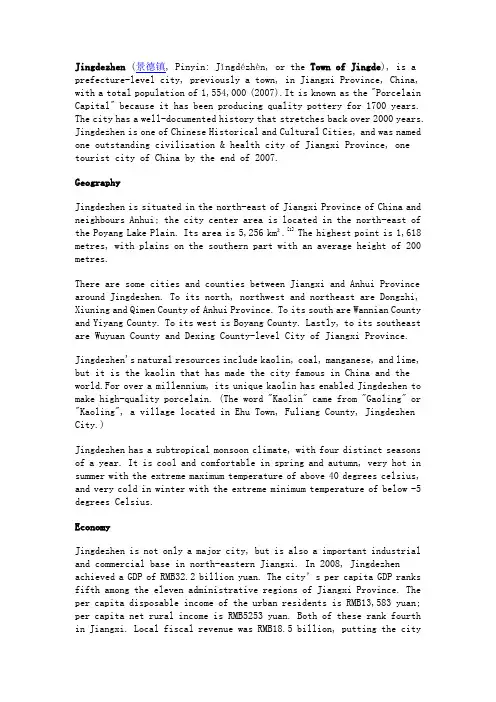
Jingdezhen (景德镇, Pinyin: Jǐngdézhèn, or the Town of Jingde), is a prefecture-level city, previously a town, in Jiangxi Province, China, with a total population of 1,554,000 (2007).It is known as the "Porcelain Capital" because it has been producing quality pottery for 1700 years. The city has a well-documented history that stretches back over 2000 years. Jingdezhen is one of Chinese Historical and Cultural Cities, and was named one outstanding civilization & health city of Jiangxi Province, one tourist city of China by the end of 2007.GeographyJingdezhen is situated in the north-east of Jiangxi Province of China and neighbours Anhui; the city center area is located in the north-east of the Poyang Lake Plain. Its area is 5,256 km².[1]The highest point is 1,618 metres, with plains on the southern part with an average height of 200 metres.There are some cities and counties between Jiangxi and Anhui Province around Jingdezhen. To its north, northwest and northeast are Dongzhi, Xiuning and Qimen County of Anhui Province. To its south are Wannian County and Yiyang County. To its west is Boyang County. Lastly, to its southeast are Wuyuan County and Dexing County-level City of Jiangxi Province.Jingdezhen's natural resources include kaolin, coal, manganese, and lime, but it is the kaolin that has made the city famous in China and the world.For over a millennium, its unique kaolin has enabled Jingdezhen to make high-quality porcelain. (The word "Kaolin" came from "Gaoling" or "Kaoling", a village located in Ehu Town, Fuliang County, Jingdezhen City.)Jingdezhen has a subtropical monsoon climate, with four distinct seasons of a year. It is cool and comfortable in spring and autumn, very hot in summer with the extreme maximum temperature of above 40 degrees celsius, and very cold in winter with the extreme minimum temperature of below -5 degrees Celsius.EconomyJingdezhen is not only a major city, but is also a important industrial and commercial base in north-eastern Jiangxi. In 2008, Jingdezhen achieved a GDP of RMB32.2 billion yuan. The city’s per capita GDP ranks fifth among the eleven administrative regions of Jiangxi Province. The per capita disposable income of the urban residents is RMB13,583 yuan; per capita net rural income is RMB5253 yuan. Both of these rank fourth in Jiangxi. Local fiscal revenue was RMB18.5 billion, putting the cityin tenth place, just above Yingtan City. Jingdezhen's GDP and local fiscal revenues are relatively low for Jiangxi Province, but the growth rate is fast. The growth rate of the per capita data is in the middle for the province. [10]Industry The French SA 321 Super Frelon, which Changhe produces under license as the Z-8There are some important industrial enterprises in Jingdezhen City, such as Changhe Aircraft Industries Corporation; Jingdezhen Ceramics; Jingdezhen Refrigeration Compressor, etc.TransportationJingdezhen is the most important transportation hub in the northeast region of Jiangxi province. Historically, Jingdezhen's main communication route was via the Chang River. It could ship its porcelain down the Chang to Poyang Lake and connected there with the Yangtze River in Hukou County, Jiangxi Province. From there the porcelain could get to the coast for export. Today, water is far less important for transporting goods. Roads, the railway and airlines have grown to be more important forms of transport of goods and people.Local transitThere was only one bus line in Jingdezhen before the 1980s, which was from Huang-ni-tou to Nan-men-tou with a total line distance of 7 kilometers. In that time , the city had no taxi service and the buses were channel-type bus, it could carry more than one hundred passengers at most at the same time. This kinds of buses were renewed when they were operated to the end of 1990s.Currently,Jingdezhen public buses and taxis are the two main means of transportation within the city. Nearly more than 20 public bus lines crisscross the city and its countryside. Taxis in Jingdezhen are plentiful; fares start at ¥5 for the first 2 kilometers.EducationJingdezhen city has three colleges or universities, and these have a total of 38,613 students and 1,306 teachers in 2007. It is also the home of the Jingdezhen Ceramic Institute (JCI), which was established in 1958. It is the only institute in China that provides advanced ceramics training and it is also well-known in Chinese and international academic circles in the field of ceramics. The other two institutions of higher educationin the city are the Jiangxi Ceramics & Art Institute and Jingdezhen College.In the city proper there are 47 high schools, called Middle Schools, with 37,200 students and 2,953 teachers. The No.1 Middle School of Jingdezhen was founded in 1940. It is famous for its success rate, relative to other schools in Jiangxi Province, in placing its students in Chinese colleges.There are also 74 primary schools in the city with 40,000 students and 1,884 teachers.Public healthJingdezhen has more than 20 medical service institutions with a total 2182 beds. Doctors and nurses number 2,672. It has the largest hospital system in the north-east of Jiangxi Province. The No.1, No.2 and No.3 People's Hospital of Jingdezhen are the most important hospitals in the city; the No.4 People's Hospital is a psychiatric hospital.Tourism and local customHuizhou architecture (Anhui Province) in Yaoli town, Fuliang county[edit] Travel OverviewJingdezhen is a major tourism destination in northern Jiangxi Province. Most of the city's tourist attractions have a link to the ceramics for which it is famous.[2] The city also provides access to nearby popular tourist areas such as Lushan, Huangshan, and Wuyuan.In 2007, Jingdezhen City earned RMB3.027 billion yuan in revenues from tourism. Tourism accounted for 11.2% of local GDP, up from its share in 2006. The number of visitors is also rising year by year as the city's transportation links to the rest of China improve.At present, Jingdezhen has the most tourist hotels of any city in Jiangxi Province. In the city there is one quasi-five-star hotel, two four-star hotels, and many three-star and other common grade hotels.Jingdezhen is located in Huangshan, Huai Yu Shan Mountains and the Poyang Lake Plain transition zone, both Chinese and foreign famous porcelain, and Foshan, Hankou, zhuxianzhen adding four famous towns, JingdezhenChina State Council announced the first 24 historical and cultural city A one and open city. By 2007, Jingdezhen has received excellent tourist city in China, the National Ecological Garden City, National Civilized Sanitary City, Jiangxi Province civilized Advanced City and so on.Over the past Jingdezhen porcelain is world famous, but now has been not so famous Jingdezhen ceramics提到江西,大家是不是马上就想到了景德镇的陶瓷?上海世博会江西馆就充分利用了这一闻名遐迩的“特产”,将外形设计成青花瓷容器。
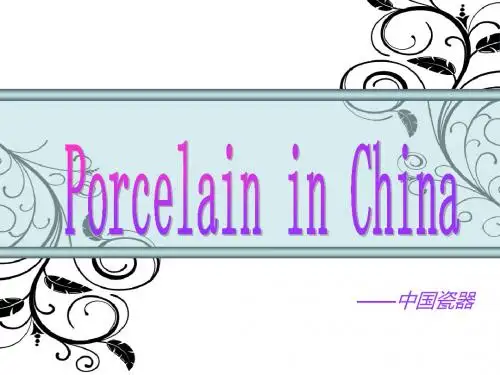
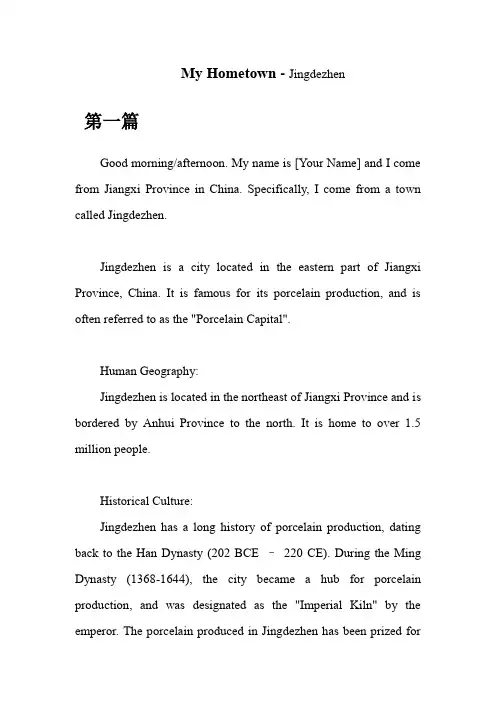
My Hometown -Jingdezhen第一篇Good morning/afternoon. My name is [Your Name] and I come from Jiangxi Province in China. Specifically, I come from a town called Jingdezhen.Jingdezhen is a city located in the eastern part of Jiangxi Province, China. It is famous for its porcelain production, and is often referred to as the "Porcelain Capital".Human Geography:Jingdezhen is located in the northeast of Jiangxi Province and is bordered by Anhui Province to the north. It is home to over 1.5 million people.Historical Culture:Jingdezhen has a long history of porcelain production, dating back to the Han Dynasty (202 BCE –220 CE). During the Ming Dynasty (1368-1644), the city became a hub for porcelain production, and was designated as the "Imperial Kiln" by the emperor. The porcelain produced in Jingdezhen has been prized forits exquisite craftsmanship and artistic beauty, and has been exported around the world.Attractions:Jingdezhen has a number of attractions for tourists. The Jingdezhen Ceramic Museum is a must-see for those interested in porcelain. It features a large collection of porcelain from different dynasties, as well as exhibits on the history of porcelain production in Jingdezhen. The Ancient Kiln Folk Customs Museum is another popular attraction, showcasing the traditional methods of porcelain production. Additionally, the city has a number of temples and historic sites, such as the Taoist temple of Dragon Light Palace and the Ming Dynasty Porcelain Pagoda.Tourism Resources:Apart from its porcelain heritage, Jingdezhen also boasts beautiful natural scenery. Lushan Mountain, located to the south of the city, is a popular destination for hiking and sightseeing. The Yangtze River also flows through the city, providing opportunities for river cruises.Specialty Food:Jingdezhen has a rich culinary tradition, with its own unique local dishes. One of the most famous is Taoxi Meat, a braised pork dish that is traditionally served during festive occasions. Other popular dishes include fish soup, Jingdezhen-style tofu, and fried rice with porcelain shard.Economic Development:Jingdezhen is a developing city, with a growing economy. The city is home to several high-tech industries, including electronic information, biomedicine, and new materials. Additionally, the porcelain industry remains a major contributor to the local economy, with over 100,000 people employed in the industry.Overall, Jingdezhen is a city with a rich cultural heritage, stunning natural scenery, and exciting economic prospects. It is a must-visit destination for those interested in porcelain, history, and Chinese culture.That's all for my introduction of Jingdezhen. If you have any questions about my hometown, feel free to ask me. Thank you!第二篇Jingdezhen, located in the eastern part of Jiangxi Province, is a city with rich cultural and historical significance. The city is known for its porcelain industry and is often referred to as the "Porcelain Capital" of China.As for its human geography, Jingdezhen is surrounded by mountains and rivers, providing a picturesque view. The city has a population of over 1.5 million people and is a mix of different ethnic groups, including Han, Hui, Miao, and Zhuang.Jingdezhen has a long and significant history, dating back over 1,700 years, and is considered one of the birthplaces of ceramic art in China. The city's porcelain industry has been renowned for thousands of years and has played a significant role in shaping the culture and economy of the region.There are numerous famous historical and cultural sites in Jingdezhen, including the Ancient Kiln Folk Customs Museum, the Porcelain Museum, and the Jingdezhen Ceramic History Museum. Additionally, the city has many beautiful temples and pagodas, suchas the Jingdezhen Pagoda and the Taoist Temple of the Five Immortals.Jingdezhen has many tourist resources, such as the Changjiang River National Forest Park, Nine-dragon Cave Scenic Area, and the Dragon Pearl Scenic Area. The city has also developed many high-end hot spring resorts that offer various spa services and scenic views.When it comes to food, Jingdezhen is famous for its local cuisine, including Jingdezhen beef noodles, Jingdezhen fried rice noodles, and Jingdezhen hot pot. These dishes are flavorful and unique, and visitors to the city should make sure to try them.In terms of economic development, Jingdezhen has experienced significant growth in recent years, with the porcelain industry driving much of the city's economy. The city is also known for its furniture and handicraft industries, which contribute to the overall economic growth of the region.Overall, Jingdezhen is a vibrant and culturally rich city with endless tourist attractions and resources. Its unique history,picturesque scenery, and delicious cuisine make it a must-visit destination in China.That's all for my introduction of Jingdezhen. If you have any questions about my hometown, feel free to ask me. Thank you!第三篇Jingdezhen, located in Jiangxi Province, is a renowned city in China for its rich history, culture, and scenic attractions. It is home to a population of over 1.5 million people, and has a diverse geography with mountains, rivers, and lakes.The city boasts a long history dating back to the Han Dynasty, and has been a center for ceramic production since the Tang Dynasty. Its rich cultural heritage is reflected in the numerous temples, museums, and historic sites such as the Ancient Kiln Folk Customs Museum, Jingdezhen Ceramic Museum, and the Imperial Kiln Ruins from the Ming and Qing Dynasties.The city is known for its beautiful scenic spots, such as the Lushan Mountain Scenic Area, Longzhu Lake, and YueliangwanPark. These attractions draw tourists from around the world and contribute to the city's thriving tourism industry. In addition, Jingdezhen is home to many famous porcelain manufacturers and is known as the "Porcelain Capital" of China, making it an ideal destination for those interested in traditional Chinese arts and crafts.Jingdezhen is also famous for its delicious local cuisine, including Steamed Fish Head, Jingdezhen Noodles, and Fish in Sour Soup. These dishes use local ingredients and are prepared according to traditional recipes, offering a unique culinary experience for visitors.In recent years, Jingdezhen has developed rapidly and has become an important economic hub in the region, with industries such as ceramics, tourism, and agriculture contributing to its growth. The city is also home to several colleges and universities, including Jingdezhen Ceramic Institute, which attracts students from around the world to study ceramics and the arts.In summary, Jingdezhen is a city with a rich cultural heritage, breathtaking scenery, and unique local cuisine. Its rapid development and economic growth make it an exciting and dynamic place to visit,and a recommended destination for anyone interested in Chinese history, culture, and art.That's all for my introduction of Jingdezhen. If you have any questions about my hometown, feel free to ask me. Thank you!。
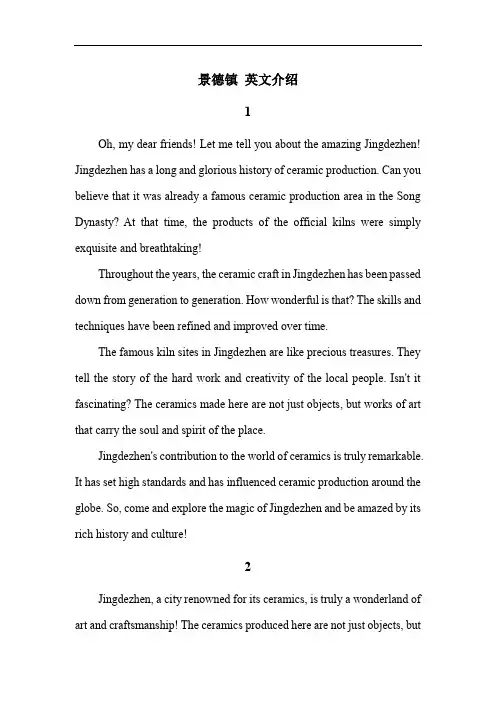
景德镇英文介绍1Oh, my dear friends! Let me tell you about the amazing Jingdezhen! Jingdezhen has a long and glorious history of ceramic production. Can you believe that it was already a famous ceramic production area in the Song Dynasty? At that time, the products of the official kilns were simply exquisite and breathtaking!Throughout the years, the ceramic craft in Jingdezhen has been passed down from generation to generation. How wonderful is that? The skills and techniques have been refined and improved over time.The famous kiln sites in Jingdezhen are like precious treasures. They tell the story of the hard work and creativity of the local people. Isn't it fascinating? The ceramics made here are not just objects, but works of art that carry the soul and spirit of the place.Jingdezhen's contribution to the world of ceramics is truly remarkable. It has set high standards and has influenced ceramic production around the globe. So, come and explore the magic of Jingdezhen and be amazed by its rich history and culture!2Jingdezhen, a city renowned for its ceramics, is truly a wonderland of art and craftsmanship! The ceramics produced here are not just objects, butmasterpieces that carry history and culture.The glaze colors in Jingdezhen are simply astonishing! The rich and vibrant hues, like the deep blue of the blue and white porcelain or the soft pastels of the famille rose porcelain, are like a symphony of colors. The craftsmanship is beyond imagination! Skilled artisans meticulously shape and decorate each piece, showing extraordinary patience and precision.Take the elegant blue and white porcelain for example. Its patterns are so delicate and refined, as if telling stories of ancient times. And the famille rose porcelain, with its fine details and smooth texture, makes one wonder how such beauty can be achieved.The variety of shapes is also remarkable. From delicate vases to elaborate figurines, each piece is a unique creation. How can one not be amazed by the creativity and artistry displayed in these ceramics?In Jingdezhen, the world of ceramics is a never-ending source of inspiration and awe. It's a place where tradition and innovation blend seamlessly, creating masterpieces that will continue to fascinate people for generations to come!3Jingdezhen, a remarkable city in China, is renowned worldwide for its outstanding ceramic industry. It is located in a strategic geographical position that plays a crucial role in its success. The rich natural environment of Jingdezhen has been a significant contributor to itsflourishing ceramic production.The abundant kaolin clay resources in this area are truly a wonder! How amazing it is that these high-quality materials provide a solid foundation for the creation of exquisite ceramics. Without this precious resource, the exquisite porcelain we admire today might not exist.The local climate conditions are also a key factor. The moderate temperature and humidity are perfect for the firing process of ceramics. Isn't it astonishing how nature cooperates so well to support this ancient art? The combination of these geographical and environmental advantages has made Jingdezhen a unique and irreplaceable hub of ceramic production.In conclusion, the location and natural environment of Jingdezhen have undoubtedly had a profound and positive impact on its ceramic industry. This city stands as a shining example of how nature and human craftsmanship can come together to create something truly remarkable.4Oh my goodness! Let me tell you about the amazing Jingdezhen and its ceramic industry! Jingdezhen, a city renowned for its ceramics, has witnessed remarkable developments in recent times. The modern technology has truly been a game-changer in the ceramic production process! Advanced techniques and machinery have enabled artisans to create more intricate and exquisite designs. How astonishing is that?Today, the ceramics from Jingdezhen are not only of high quality butalso showcase a perfect blend of tradition and innovation. The attention to detail and the pursuit of perfection are still at the core of every piece.What's more, the future of Jingdezhen's ceramics looks incredibly bright! With its unique charm and superior craftsmanship, these ceramics are set to make a splash in the international market. Isn't it exciting to think about? They will surely capture the hearts of people from all over the world.In conclusion, Jingdezhen's ceramic industry is flourishing and has a promising future ahead. It continues to be a source of pride and inspiration. So, keep your eyes on this wonderful place and its amazing ceramics!5Jingdezhen, a city renowned worldwide for its exquisite ceramics, has played an indispensable role in cultural exchanges! The porcelain produced in Jingdezhen is not merely an art form but a messenger that bridges the gap between different cultures. How remarkable it is! For instance, the unique blue and white porcelain of Jingdezhen has charmed countless foreigners. They are astonished by the delicate patterns and superb craftsmanship. Isn't it a wonder that these ceramics have sparked interest and admiration in foreign lands?In international exhibitions, works from Jingdezhen always attract the most attention. The vivid colors and intricate designs of the ceramics tell stories of China's long history and rich culture. Oh, how they have opened the door for people from all over the world to understand the depth andbeauty of Chinese culture!The ceramics from Jingdezhen have become a symbol of cultural exchange, spreading the charm of Chinese art to every corner of the world. How could we not praise the significant contribution of Jingdezhen ceramics in facilitating cultural communication? They truly are a precious treasure that continues to shine on the global stage!。
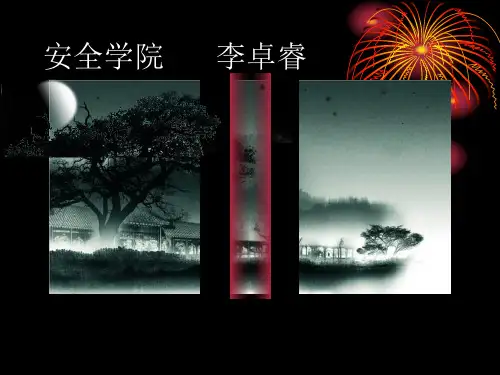
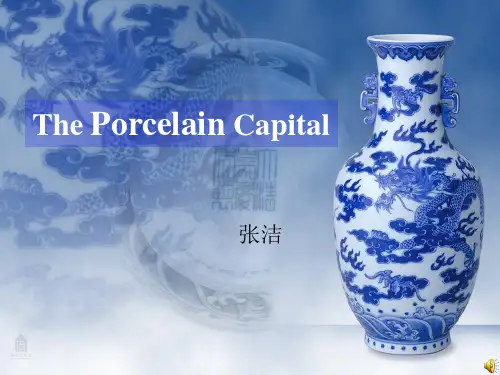

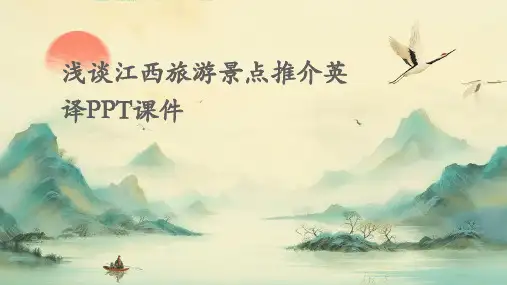
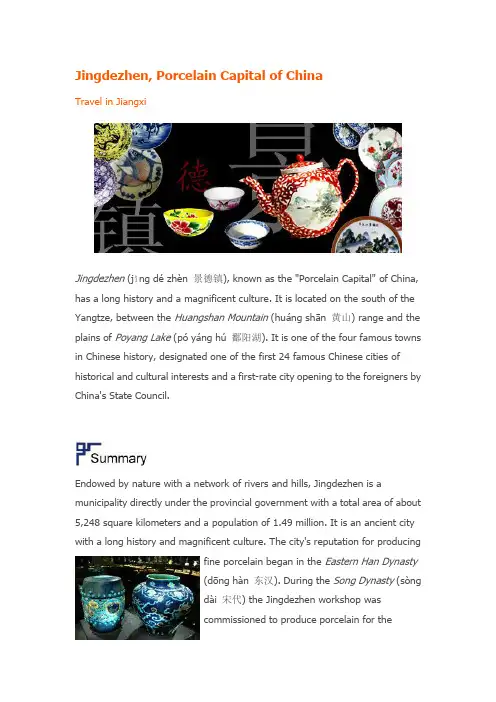
Jingdezhen, Porcelain Capital of ChinaTravel in JiangxiJingdezhen (jǐng dé zhèn 景德镇), known as the "Porcelain Capital" of China, has a long history and a magnificent culture. It is located on the south of the Yangtze, between the Huangshan Mountain(huáng shān 黄山) range and the plains of Poyang Lake (pó yáng hú 鄱阳湖). It is one of the four famous towns in Chinese history, designated one of the first 24 famous Chinese cities of historical and cultural interests and a first-rate city opening to the foreigners by China's State Council.Endowed by nature with a network of rivers and hills, Jingdezhen is a municipality directly under the provincial government with a total area of about 5,248 square kilometers and a population of 1.49 million. It is an ancient city with a long history and magnificent culture. The city's reputation for producingfine porcelain began in the Eastern Han Dynasty(dōng hàn 东汉). During the Song Dynasty (sòngdài 宋代) the Jingdezhen workshop wascommissioned to produce porcelain for theimperial court. It enjoys a monsoon subtropical climate. Its climate is characterized by adequate sunshine, sufficient rainfall and obvious distinctions between the four seasons. The annual average temperature in the city is 17 C. The main products are porcelain stone, Kaolin, marble, tea, paddy, soybean, wheat, peanut, rapeseed etc.Since the period of Han Dynasty (hàn dài 汉代), Jingdezhen has had the ceramic industry. Up to now, it has more than 2000 years of history. Traditionally, Jingdezhen was titled Ceramic Capital. Porcelain of Jingdezhen has a beautiful shape, various types, rich decorations and unique styles. It is worldwide famous for its color as white jade, brightness as bright mirror, thinness as paper and sound as music. Qinghua Porcelain (qīng huā 青花), Linglong Porcelain (líng lóng 玲珑), Fencai Porcelain(fěn cǎi 粉彩) and Seyou Porcelain (sè yòu 色釉) altogether are called Four Traditionally Famous Porcelains in Jingdezhen.1. Ancient Porcelain Street (gǔdài cí qì jiē 古代瓷器街)It is in the center of Jingdezhen. It was the most busy and bustling street in the late Ming (míng dài 明代) and early Qing Dynasties(qīng dài 清代), now renowned for its long history and beautiful traditions that come from its ancient culture. The street is composed of three parts, each of which fully reflects itsprosperous past. Exquisitely designed and decorated residences were clearly the elite residences of their time and demonstrate the highest skills and architectural knowledge of Chinese artisans of their eras.• Admission Fee: Free2. Ceramic History Museum (jǐng dé zhèn táo cí bó wù guǎn 景德镇陶瓷博物馆)Located in the western suburb of Jingdezhen City,It is a professional ceramic museum built in 1980,with a rich collection of over 5,000 articles. Theitems on display include ceramics from pastdynasties, historical information about ceramics,precious collections of paintings and calligraphies, among which many are of excellent quality.• Admission Fee: CNY 103. Longzhu Pavilion (lóng zhū gé 龙珠阁)Longzhu Pavilion is located on the top of the Zhushan Mountain (zhū shān 珠山) of Jingdezhen. It is a monument to Jingdezhen's ceramic industry. In the Ming and Qing dynasties, it was a place for making ceramics for the imperial family which means there are a lot of precious culture relics of those two dynasties on display.• Admission Fee: CNY 154. Yuyao Factory (yù yáo chǎng 御窑厂)The early Ming Dynasty, Yuyao factory was established. Yu means, the emperor dedicated. Yao means, Kiln, the place where produce porcelain. China is a country of porcelain, and we can say that the porcelains which Yuyao made during Song, Yuan, Ming and Qing dynasties were the best in the world.• Admission Fee: CNY 155. Fuliang Ancient County Government (fú liáng gǔxiàn yá 浮梁古县衙)The Fuliang Ancient CountyGovernment is in the suburb ofJingdezhen. It is a well preservedancient county government site,which was set up 1,100 years ago.In it, you can see the official robes, sedan chairs and even instruments of torture. Visiting the site of the ancient county government is really a good chance to understand the politics of ancient China.• Admission Fee: CNY 506. Ming Qing Garden (míng qīng yuán 明青园)Ming Qing Garden is located in Jingdezhen porcelain sculpture factory. It is Jingdezhen international ceramics center. Construction of Chinese Ming Dynasty style. The porcelain street is a copy of ancient Jingdezhen. Many artists have studios here,showing intricate art of ceramic sculpture.• Admission Fee: CNY 107. Yaoli (yáo lǐ瑶里)Yaoli is in Fuliang County which is 50 kilometers from downtown Jingdezhen. With good forest coverage, abundant animal resources, characteristic lanes, the town is well-known for its beautiful natural scenery. Additionally, it is the cradle of Jingdezhen's ceramics industry. Gaoling(gāo lǐng 高岭) Village located in Yaoli once provided enough raw materials for making porcelain in the ancient times. Today, Kaolin, a world famous kind of clay, is named according to its Chinese pronunciation.• Admission Fee: CNY 1508. The Moon Lake (yuè liàng hú月亮湖)The Moon Lake Scenic Area lies in Liyang Town(lì yáng xiāng 丽阳). It is 10 kilometers from downtown Jingdezhen. There are many hills and lots of wild birds inhabit the area. It got the name because of its moon-shape. Besides the charming scenery, it has some entertainment facilities, such as motorboats and luxury speed boats and also you can enjoy fishing there.9. Red Tower (hóng tǎ红塔)Because the wall is red, so the tower called Red Tower.By TrainThe WanGan (wǎn gàn 皖赣) Railway (Anhui - Jiangxi) connects Jingdezhen to many key cities in China. The Jingdezhen Railway Station is located in the city center.By AirJingdezhen Airport is located at Luojia Village(luó jiā cūn 罗家村), northwest of Jingdezhen City, about 8 kilometers from the city downtown. There are no international flights.Getting aroundJingdezhen public buses and taxis are the two main means of transportation within the city. Nearly more than 20 public bus lines crisscross the city and itscountryside. Taxis in Jingdezhen are plentiful with fares starting at CNY 5 for the first 2 kilometers.Cold Vermicelli(lěng fěn 冷粉). This is one brand name of Jingdezhen snacks. It is different from vermicelli of other regions. The vermicelli is thicker and has a half centimeter of diameter. It is also has the diversities of seasonings such as bean sauce, pepper sauce, orange peel, garlic and ginger.Jiaoziba (jiǎo zǐbā 饺子粑). Jiaoziba generally is taken as the breakfast and night food. Diversities of stuffing covered by powder-made slice are steamed on steam boxes. Through the thin slices, eaters can see the stuffing clearly. Additionally it has different taste after fried. Generally the stuffing is divided into hot and non-spicy. The spicy stuffing is made of the carrot slices, and the non-spicy stuffing is made of the eggs with leeks. Additionally it also has the stuffing made of the bean sprout and bean-curd.Xianshuiba (jiǎn shuǐpá 碱水耙). This is the classical snack in Jingdezhen. Xianshuiba generally is unavailable in other areas, and it can be eaten during the time of Lunar Spring Festival. It is delicious, and will be more tasteful if you cook it with eggs or add some preserved vegetable.。
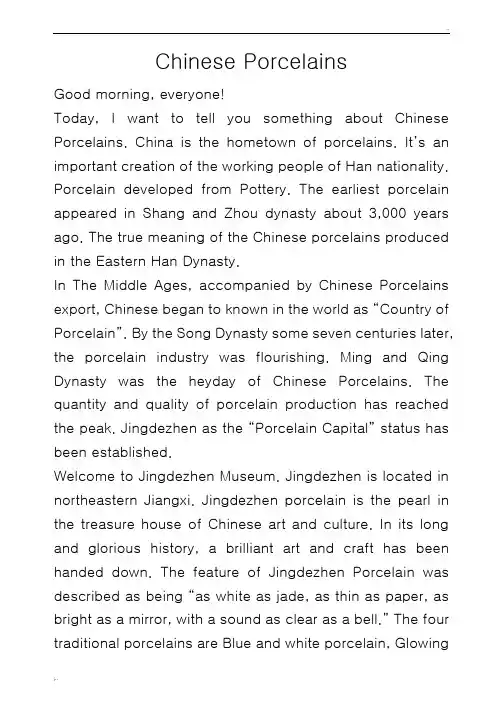
Chinese PorcelainsGood morning, everyone!Today, I want to tell you something about Chinese Porcelains. China is the hometown of porcelains. It’s an important creation of the working people of Han nationality. Porcelain developed from Pottery. The earliest porcelain appeared in Shang and Zhou dynasty about 3,000 years ago. The true meaning of the Chinese porcelains produced in the Eastern Han Dynasty.In The Middle Ages, accompanied by Chinese Porcelains export, Chinese began to known in the world as “Country of Porcelain”. By the Song Dynasty some seven centuries later, the porcelain industry was flourishing. Ming and Qing Dynasty was the heyday of Chinese Porcelains. The quantity and quality of porcelain production has reached the peak. Jingdezhen as the “Porcelain Capital” status has been established.Welcome to Jingdezhen Museum. Jingdezhen is located in northeastern Jiangxi. Jingdezhen porcelain is the pearl in the treasure house of Chinese art and culture. In its long and glorious history, a brilliant art and craft has been handed down. The feature of Jingdezhen Porcelain was described as being “as white as jade, as thin as paper, as bright as a mirror, with a sound as clear as a bell.” The four traditional porcelains are Blue and white porcelain, Glowingporcelain, Color glaze porcelain, and Famille-rose porcelain.Blue and white porcelain has a white base with blue designs. Blue designs are applied to the white body of the porcelain, making it appear elegant, fresh and full of vigor. Its unique artistic connotation is the perfect combined of traditional and modern arts.Glowing porcelain is also called “Mitong”in China. Craftsmen carve out many regular “delicate eyes”in the porcelain body, and then fire these holes with the glaze into the bright hole. European called it as “the transparent rice pattern”.Jingdezhen’s colorful glaze is famous for all over the world. It contains a long tradition, and is gradually concluded by our ancestors during the long-time producing and experimenting. Our ancestors had accumulated rich experience in the long time producing and struggling. Famile-rose porcelain also called soft decorative porcelain, which is one of the four traditional porcelain of Jingdezhen. As known as soft colors, is over glaze decoration of porcelain wares. “A man without porcelain is not noble. A room without porcelain is indecent.”Porcelain is ubiquitous in our culture.Thank you for your attention. Next, we will have a lunch in a five star hotel.彭雅玲。
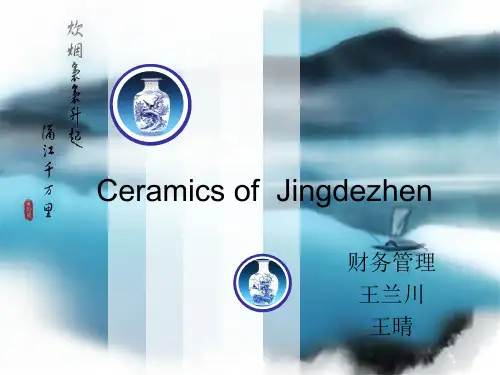
景德镇英文导游词(九江学院涉外旅游旅B0821班)A Tour-Guide’s speech for the “Ancient Kilns Factory”in JingdezhenLadies and Gentlemen,we use china,or porcelain,everyday,so I’m sure all of you are very familiar with it.But do you know how it is produced?Now we have a good chance to find out,because we are going to visit Jingdezhen,the porcelain capital of China.I will invite you to visit the “Ancient Kilns”china factory today .We’ll find out why the factory is so named. But now please allow me to introduce some information about porcelain to you on the way to the factory.Evrybody needs to eat, and you need containers to hold and serve your food, so china was invited early in human history. In prehistoric times, lightning started forest fires, which sometimes made the soil become hard. We think that this phenomenon probably inspired the invention of pottery. People smeared baskets with wet clay, then put them into a fire, to make pots which could hold water and store grain or food. This was a great advance for civilization, and the Chinese invented earthenware about five or six thousand years ago. Earthenware gradually evolved into chinaware. But they are different, Chinaware is finer, smoother and harder than earthware. Chinaware is made from china ore, but earthenware is made of pottery clay. The firing temperature of chinaware is about 1300°C, but earthenware is fired at 1000°C at most.Chinaware is one of the greatest inventions of Chinese people. During the Shang dynasty in the 16th century B.C, the Chinese people improved the material and manufacture of pottery .While they were making white pottery and pottery with patterns on it,they started to raise the firing temperature and were able to create primitive chinaware.It is said that when chinaware was first delivered to Europe,the ancient Europeans were astonished by these wonderful hard bowls.They didn’t know what the material was,and they didn’t even have a word to describ it ,they only knew it came from China,so they named it “china”after the country.“China is called the chinaware country,Jingdezhen is the pearl of the chinaware industry.” Such lines are often used to describe the important role JDZ plays in Chinaware history.Jingdezhen is famous all over the world for producing china and it is often called the “porcelain capital of China”.In ancient times the city was named “xinping”. An ancient document records that, “xinping city has been manufaturing china since the Han Dynasty.”That means china-making has at least 1,700 years history in JDZ. The name Xinping was changed to Jingdezhen later. Do you know why? The chinaware industry thrived in this city during the Song Dynasty, and “YingQing”china(which uses a special kind of green glaze called “celadon”) was invented at that time. It became famous all over the country, and even all over the world. During the Jingde years of the Song Dynasty(1004-1007), the king, called zongzhen or Zhaoheng, attached great importance to the place where “yingqing”china was produced, he ordered the workers to make china just for the palace—this was called “imperial china”, and this batch of imperial china was particularly elegant because of the workers’elaborate labour, and it was branded with the words “made in the Jingde years.”As a result, people began to call it “Jingde”china, and the city renamed “Jingdezhen” by the imperial government. In Chinese “zhen”means “town”.Of course, Jingdezhen has now developed into a medium-sized city with apopulation of over 1 million, so it’s much bigger than in the past. In 1953 it was listed as a city in Jangxi Province. So s ome people said that it should be called“Jingdeshi”(“shi”means“city”). However, the name---“Jingdezhen”had a long history and was recognized over the world. It was not appreciated to change it. Thu s the city is still called “Jingdezhen”-so really the name means,”Jingde-town-city”.JDZ is a place where the fire in the kilns has been burning continuously for more than 1000 years, it is also a place where the chinaware industry has been handed down from generation to generation. In its history, inventions emerged in an endless stream. For instance, a new formula (配方)of the material to make china was created during the last years of the Southern Song Dynasty. It is called the binary formula because it mixes china ore and kaolin. And many famous kinds of porcelains were created in history, such as blue-and-white porcelain, glazed coloured porcelain, and rose-powdered porcelain.JDZ porcelain has developed its own flavour during its long history. It is as white as jade, as bright as mirror, as thin as paper, as clear as bell when tapped. So today is a good day to feast our eyes.Now we have arrived at the “Ancient Kilns factory”. So I’ll tell you more about Jingdezhen porcelain during our visit.This is PanLong hill, which is located to the west of Jingdezhen. Over there is an ancient building complex and that is the highlight we are going to visit today, the Ancient Kilns Factory. There are lots of china factories, especially modern ones, in many places both in China and other countries. There are certainly plenty of china factories in Jingdezhen, but, as far as I know, there is only one factory like this in the world. This factory uses a method dating from the Ming and the Qing Dynasties to make china. The technologies, tools, workshops and kilns are all very ancient, and most of the products are modelled after antiques. That’s why the factory is called the“Ancient Kiln”factory.Now we’re going inside, so please follow me.You won’t be able to hear the noise of machines here. The path under your feet is paved with blue flagstones and modern installations, such things as electric wires and poles have been hidden. Sometimes it’s good to be far away from the noise of the city, isn’t it? The factory was founded in the early 1980s and has an area of more than 40 hectares. It has been open to the public since it was founded and china is manufactured according to an ancient method. The factory was founded for 3 purposes, first, to preserve the traditional methods of making china by hand, which have been handed down from the Ming Dynasty, second, to reproduce the official process of making imperial china from the Ming and the Qing Dynasties. In addition, there were many workshops and wood-burning kilns scattering around the city, and they were moved here for restoration, so the factory provides a good cover place for the workshops and kilns. As a result, the inheritance for the chinaware industry is well-preserved here. So it is a place of never-missing when you come to JDZ.The workshops are called“clay-house”and each one covers about 600 squ are metres. Their shapes and internal layout are nearly the same, but the products made in different workshops are different, because they are different in technology and equipment. Now let’s go inside to see what the workers are doing.Please look,the ancient china workshops were just like this. The house consists of four parts: the main-room, the “ao”room(or warehouse),the clay-room and the inner-courtyard. The main-room and the warehouse are parallel, sitting opposite each other to the north and south. Theclay-room is to the west, and the rectangular yard lies in the middle. All the rooms open onto the courtyard, so they make a sealed unit and have good light in which worker, buildings and nature are in perfect harmony.The main rooms is the main body of the clay-house. It faces south and has good light. Everything that needs to be done before the china is to be fired in the kiln is completed in this room.The warehouse is used to store the raw materials, it is called Aojian in Chinese. It is near the eastern gate to make the transportation easy.The clay-room is in the west. It’s a very cool room used to hold the refined clay powder, which is finer and smoother than prepared flour. In the past, the workers trampled(践踏)the clay here. But the trampled clay would be stored for some time before it was used to make any china.Why do you think they do this? It’s to eliminate any orga nic matter or air which might be mixed into the clay, because any impurities would affect the quality of the china. So, the longer you store and knead the clay, the better quality your china will be.Now let’s look at the inner yard. It is the place for the china to dry naturally before firing. There is a retangular pool which is over 2 metres long and 2 metres deep in the middle of the yard and there is a wooden frame over it. They have a joint name in Chinese, Saijiatang, which means, “pool with drying frame”. They were vitally important in the ancient workshop, and they’re very ingenious. Many guests wandered about what they are uesed for. Can you make a guess at it? Firstly, as you see, as the frame is placed over the pool, full use can be made of the space. Secondly, when it rains, the pool becomes a container to hold rainwater, and the rainwater is used for washing the clay powder, so it’s convenient and labour-saving to store water here. But there is another reason too,we all know that water evaporates, and the rate of evaporation varies as the air temperature and humidity change in the drying area above the pool. That means the climate of the area can be controlled to some degree, and the drying speed of the china on the frame can be adjusted. The china dries slowly, so it contracts equally. Therefore, faults and cracks can be decreased or eliminated.Buiscuit modeling: This is the potters’ wheel. I t is the main equipment used when forming the various china articles. This is called the clay-rack, and it holds rows of semi-finished china. Shelves like this make full use of the upper space in the room. Most of the china articles are completed on the wheel. Look, the workers sit on the seat and rotate (旋转)the wheel with a stick. They made the articles as the wheel spins quickly. When the wheel slows down, they rotate it again. Thus,the room is quiet and harmonious without the sound of a motor, since the wheel keeps spinning under its own inertia(惯性). Let’s watch the master forming a bowel. First he puts a lump of clay on the wheel, he moulds the clay with his hands,and you can see the form of the pot appearing as the wheel spins. Articles such as bowls,jugs,cups and plates are all made in this way. The workers’hands are so clever that they can make anything.Substration: after modeling, articles look the same, but they are different in details. So we need substration to make the inside of the articles uniform first, that is what the workers here do. This is the mould, when the biscuits are semi-dried, they will be put on the mould, and the workers will use a piece of wood to pat it, then each biscuit comes out with the same inside.Shaving or trimming(整理): if substration is to get the same inside, trimming is to get the same outside. The workers here will put the substrated biscuits on the wheel, and turn the wheel. They use different cutting tools to trim the outside of the biscuits until they are finally shaped thesame. When the biscuits turn, unnecessary parts are removed. But in this process, the worker has no measuring tools, instead he must rely on his eyes, hands and ears for this task. For example, if the biscuit is big enough, the worker will snap his fingers inside it and then listen to the sound. This can help him to assess the thickness of the china. Each article is shaved again and again to form the semi-finished product, which is well-shaped and of the correct thickness. Of course,only a very experienced worker can use the sound of his snapping fingers to assess the thickness of an article-this skill cannot be mastered quickly!Tang Ying, a famous china inspecter during the Qing Dynasty, once said, “The quality of the china depends on the skill of the worker who does the shaving, so this is the key worker.”Biscuit painting: this is the place where workers paint the biscuits with blue. Female workers usually do the job. Blue is often used as a glaze. Now you see it is ash black, but it will come out brightly blue after firing.The paint/pigment consists of many ingredients, among them lead oxide dominates. (what is the correct proportion of different ingredients, guess what he answered me, if I got the proportion, he would lose his job, and there would be another millionare in the country)When the workers have finished drawing the designs, they will coat the articles with a tansparant glaze. After that,the articles will be placed in the kiln for firing.In this clay-house,the articles are processed from raw material to fully-formed and decorated bowls.How do you feel about this special Jingdezhen china workshop?We think it has a simple appearance and compact layout. It’s economical,practical and convenient to manage,so it’s the best combination of functioning structure and style.How do we turn these articles into the finished product? Workers take them to the kiln-house and pack them into a small box. Then they will be put into the kilns for firing at temperatures of more than 1300°C. Now, let’s go to visit the kiln-house.This unique wood-burning kiln, found only in Jingdezhen, is in this simple ancient house. Please take a look at the chimney. Can you see that the top is not round but pointed like the tip of a pen? Why do you think this is? Some experts think it is to reduce the influence of the wind on the draft of the chimney. This will make the draft relatively even rather than a mixture of strong and weak.The wood-burning kiln is also called a “Zhen”kiln.This kiln has been listed as an important historical relic at the provincial level. In ancient times, it was an important and key piece of equipment for making china. It uses pinewood for fuel, and it’s the most suitable kiln for firing special traditional china, especially glazed coloured porcelain. This kiln is 18 metres long and is oval in shape, like half an eggshell. Behind it, there is a 21-metre-high brick chimney. The walls of the chimney are 8 to 9 centimetres thick. The chimney joined to the kiln with a mud seal. And it tilts at an angle of 8 degrees. Just like the Pisa Tower. Why is this? An angle of 8° can greatly improve the strength of the chimney.The wood-burning kiln is the crystallization of the wisdom of the Jingdezhen china workers. It combines knowledge of thermodynamics, mechanics and materials science. It is very practical, its capacity is so large that it can fire several varieties of china, 8 to 15 tons at a time. For example, one kiln can fire more than 100 different kinds of glazed coloured porcelain at the same time. It has such a high thermal efficiency that firing one kilogram of china will only use two to two and a half kilograms of wood.Let’s go inside to take a look. This special kiln is supported by pillars placed so as to makesquares. All the pillars are natural tree trunks, which have had their branches cut off and their bark removed. The workers made clever use of the curved trees for the structural frame, which greatly improved the strength of the kiln. The second floor is used to hold the wood and each square metre can bear more than 1 ton. It is said that an earthquake occurred in Jingdezhen during the Ming Dynasty. Many houses collapsed,but this kiln stood firm.The workers put the boxes full of different kind of china into the kiln according to the manager’s plan. 20 or so workers co-operate in this task. It takes about 8 hours to fill the whole kiln. Then the kiln will be sealed and the china will be fired for about 24 hours. After that, the workers will damp down the fire to cool the china for at least one night. When the china is taken from the kiln we can finally see the finished product. It is very exciting to open the kiln. And there used to be a great ceremony before opening the kiln. All the china is the same colour when it is put in, but it has become colourful by the time it is taken out.Firing over 10 tons of china in a kiln at one time certainly requires complicated technology. However,from the ancient times to the present there have never been any temperature gauges in this kiln, nor equipment to help the workers control the firing process. The workers were still using kerosene lamps for light in the early 1960s. Firing china in a wood-burning kiln depends on the experience of the workers, strict cooperation and division of labour. There is one general manager in charge of firing the china. He is called the “gang master”and he has full powers to deal with any difficulties. The most important thing is how to decide when to damp down the fire towards the end of the firing process. If the firing time is too long, the china will turn yellow in the kiln,or it may even collapse. If the firing time is too short, the china will be unfinished. The gang master decides when to damp down the fire depending on his observation of the color of the fire through the mouth of the kiln. And he can also sipt into the kiln and make a decision depending on the reaction of the spittle in the fire. The gang master’s skills are exceptional, and there are many legends about various gang masters. The most famous is about Tong Bin jumping into the kiln.Now let’s go to visit the china-exhibition hall to get a general overview of the different kinds of china made in Jingdezhen.What are your feelings when you see this superb collection of beautiful china? The purist china is described like this, “as white as jade, as bright as mirror, as thin as paper, as sound as a bell.” These charateristics are fully reflected by the porcelain in this hall. The Jingdezhen people are proudest of blue-and-white porcelain, exquisite porcelain, rose-powdered porcelain, glazed-corloured porcelain and eggshell porcelain. You can see all of them in this hall, so please take some time to appreciate them.。